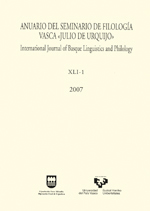Noticias sobre lingüística histórica (I)
##plugins.themes.bootstrap3.article.main##
##plugins.themes.bootstrap3.article.sidebar##
Resumen
The goal of the following reviews (originally written during the summer time of 1999-2002 and 2005) is to offer a constructive critic of recent works on historical linguistics devoted to the main exercise of the discipline: to proof or disproof the validity of alleged genealogical/genetic links. Although it is totally true that comparative and historical linguistics may have other goals, sometimes much more humble and reduce in scope (as it will be reflected in some of the next paragraphs commenting upon the work of responsible historical and comparative linguists), it is only by means of the procedures of this discipline that proposals of such a kind might be evaluated.
As is well known among specialists in the field, such a task (proving the genealogical/genetic link of two or more given languages), immense in any sense of the word, is not always carried on with the appropriate care required by the discipline. The comparative method, one of the most powerful tools the researcher can made use of with reliable results, has very concrete rules that should be applied in consequence. However, the misuse of the comparative method not always is the main reason why a particular proposal has to be at the end refuted. In the majority of cases, it can be observed a surprising (and painstaking) unknowing of the involved language(s) and/or the most elemental philological principles. Moreover, authors of long-range genealogical/genetic proposals do not take into consideration further implications of their own proposals, e.g. archaeological, historical, etc., in that way making even harder the positive evaluation of their work.
Far from what people's intuition may consider at this respect, the incorrectness in the usage of the comparative method not always corresponds to «outsiders» that because of their academic training alien to linguistics had neither time nor chance to make acquaintance with it. Sometimes, very well trained linguists, working even in the field of historical and comparative linguistics, can get all wrong and apply it with terrible consequences not only for their own work, but for an entire discipline.
Cómo citar
##plugins.themes.bootstrap3.article.details##
Esta obra está bajo una licencia Creative Commons Atribución-NoComercial-SinDerivadas 4.0 Internacional.


